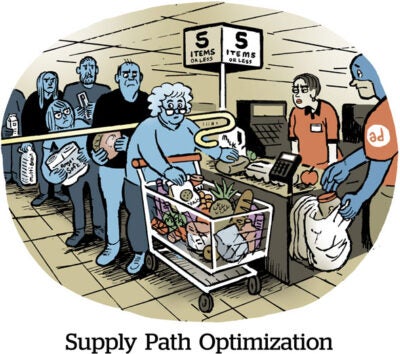Connected TV supply paths are anything but stable.
TV inventory shrinks as supply paths proliferate, and programmatic platforms are disintermediating each other despite claiming not to. Meanwhile, media buyers are stuck in a maze of multiplying supply paths and contending with the much-despised ad tech tax.
To help organize the chaos, video measurement provider and ad server Innovid launched a new supply-path optimization product for direct CTV buys on Tuesday called Harmony Direct.
Its purpose is to give media buyers the “shortest and most efficient path” to CTV supply by creating a direct connection to publisher ad servers, CEO Zvika Netter told AdExchanger.
During beta tests, which included Roku and PMG, buyers saw roughly 8% more of their campaign budgets go toward working media (as opposed to middlemen), while publishers improved inventory yield by 15%.
Be direct
Although frequency management and creative optimization are both major pain points for advertisers, buyers particularly struggle with having to manage too many supply paths.
With Harmony Direct, a media buyer sets up a programmatic guaranteed or PMP deal directly with a publisher and then uploads the deal ID into Innovid’s campaign dashboard. Through an integration with the publisher’s ad server, Innovid allows buyers to track and optimize their campaigns without relying on a DSP.
To buyers, the Harmony Direct dashboard looks and feels like a self-serve ad platform, said Miles Fisher, senior director and head of emerging and programmatic sales at Roku. Although the actual ad buying happens within the publisher’s tech stack, the product operates more like a direct deal (albeit an automated one), he said.
According to Netter, most CTV ad buys still happen directly because buyers can get more transparency into where ads run and how they perform. And media buyers doing direct deals have even less of a reason to fork over fees to a DSP for bidding and targeting.
As for campaign management and optimization, “the value proposition you would think exists in a DSP exists in the ad server,” said Mike Treon, the video and CTV strategy lead at PMG. Using Innovid, the agency can see a campaign’s pace and performance without unnecessarily paying an intermediary, Treon said.
And through integrations with publisher ad servers, Innovid can provide buyers with a more complete view of available inventory and impression delivery across publishers, compared with DSPs and SSPs that only see their own sliver of supply.
That vantage point helps media buyers compare the audience overlap between different streaming services and, in turn, find new viewers and manage ad frequency accordingly, Treon said.
Using Innovid’s ad server for campaign management also saves an agency the time and money required to upload plans into an array of DSPs that access overlapping supply, he said.
Keep your options open
But Innovid has a couple of disclaimers about its new SPO product.
First, although it’s building closer connections to publisher ad servers, Innovid isn’t touching any part of the actual media transaction. “We’re not trying to be a DSP, SSP or an ad exchange – we’re a software company,” Netter said. The point of Harmony Direct is “simply to automate workflows.”
Netter is adamant on this point because, in ad tech land, companies that transact and measure media have a conflict of interest since their campaign reporting could influence the cost of the media they buy on behalf of clients. Playing both sides is a no-no.
Secondly, although the term SPO can imply disintermediation, Harmony Direct is not designed to put DSPs or SSPs out of business.
There are plenty of capabilities DSPs have that Innovid does not because it doesn’t deal in media transactions. DSPs provide digital-style targeting capabilities and allow buyers to bid on inventory from different publishers through integrations with an array of SSPs.
For Roku, using Harmony Direct “doesn’t mean we’re moving away from DSP or SSP tech stacks by any stretch,” Fisher said. As a publisher and a distributor, Roku needs to make its inventory available through as many paths as possible so it can maximize ad revenue.
But advertisers also want efficiency, Fisher said, which means Roku needs to pave direct paths for buyers, too.
Besides, there are benefits on both sides of the transaction, he added. When more money goes toward actually buying media, it means more money in a publisher’s pocket.


















